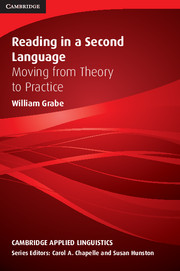Book contents
- Frontmatter
- Contents
- Series editors' preface
- Preface
- I FOUNDATIONS OF READING
- II PATTERNS OF VARIATION IN READING
- Chapter 6 Reading in different languages
- Chapter 7 L1 and L2 reading relationships
- Chapter 8 The social contexts of reading
- Chapter 9 Motivation for reading
- III DEVELOPING READING COMPREHENSION ABILITIES
- IV EXPANDING READING COMPREHENSION SKILLS
- References
- Author Index
- Subject Index
Chapter 6 - Reading in different languages
from II - PATTERNS OF VARIATION IN READING
Published online by Cambridge University Press: 05 August 2012
- Frontmatter
- Contents
- Series editors' preface
- Preface
- I FOUNDATIONS OF READING
- II PATTERNS OF VARIATION IN READING
- Chapter 6 Reading in different languages
- Chapter 7 L1 and L2 reading relationships
- Chapter 8 The social contexts of reading
- Chapter 9 Motivation for reading
- III DEVELOPING READING COMPREHENSION ABILITIES
- IV EXPANDING READING COMPREHENSION SKILLS
- References
- Author Index
- Subject Index
Summary
At the neuronal level, a person who learns to read in Chinese uses a very particular set of neuronal connections that differ in significant ways from the pathways used in English. When Chinese readers first try to read in English, their brains attempt to use Chinese-based neuronal pathways. The act of learning to read Chinese characters has literally shaped the Chinese reading brain.
(Wolf, 2007: 5)This chapter outlines some of the differences in learning to read in differing L1s. Because different languages vary in their phonological, orthographic, morphological, syntactic, and semantic systems, a given L1 and L2 could be quite different from each other linguistically. Generally speaking, the linguistic differences, or linguistic distance, between any given L1 and L2 will be a factor to consider in L2 reading development. When two languages are more distinct linguistically, there is a greater likelihood (though no guarantees) that there will be greater linguistic processing interference. An examination of reading in different L1s helps to interpret the notion of linguistic distance as a useful concept. Moreover, the exploration of reading development in different languages can help identify the extent to which there are universals of reading development and the extent to which the interaction between a given L1 and L2 will create unique issues for learning and instruction. This issue of different patterns of L1 reading development provides additional perspectives on some of the difficulties that L2 readers might face as they learn to read an L2.
In exploring reading development in different languages, this chapter does not make any claim for comprehensiveness.
- Type
- Chapter
- Information
- Reading in a Second LanguageMoving from Theory to Practice, pp. 109 - 128Publisher: Cambridge University PressPrint publication year: 2008

